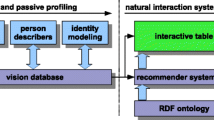Abstract
We propose and evaluate a system for content-based visualization and exploration of music collections. The system is based on a modification of Kohonen’s Self-Organizing Map algorithm and allows users to choose the locations of clusters containing acoustically similar tracks on the music space. A user study conducted to evaluate the system shows that the possibility of personalizing the music space was perceived as difficult. Conversely, the user study and objective metrics derived from users’ interactions with the interface demonstrate that the proposed system helped individuals create playlists faster and, under some circumstances, more effectively. We believe that personalized browsing interfaces are an important area of research in Multimedia Information Retrieval, and both the system and user study contribute to the growing work in this field.










Similar content being viewed by others
References
Collares L, Tavares TF, Feliciano J, Gao S, Tzanetakis G, Gooch A (2013) Soundanchoring: content-based exploration of music collections with anchored self-organized maps. In: Proceedings of the 2013 sound and music computing conference, pp 768–775
Downie JS (2003) Music information retrieval. Annual Review of Information Science and Technology 37(1):295–340
Eisemann L (2000) Pantone’s guide to communicating with color. Grafix Press, Ltd, Florida
Gasser M, Flexer A (2009) FM4 soundpark audio-based music recommendation in everyday use. In: Proceedings of the 6th sound and music computing conference
Giorgetti G, Gupta S, Manes G (2007) Wireless localization using self-organizing maps. In: Proceedings of the 6th international conference on information processing in sensor networks. ACM, pp 293–302
Goto M, Goto T (2005) Musicream: new music playback interface for streaming, sticking, sorting, and recalling musical pieces. In: Proceedings of the 6th international conference on music information retrieval, pp 404–411
Holm J, Aaltonen A, Siirtola H (2009) Associating colours with musical genres. Journal of New Music Research 38(1):87–100
Knees P, Schedl M, Pohle T, Widmer G (2006) An innovative three-dimensional user interface for exploring music collections enriched with meta-information from the web. In: Proceedings of the ACM multimedia, pp 17–24
Kohonen T (1982) Self-organized formation of topologically correct feature maps. Biol Cybern 43(1):59–69
Kohonen T (2001) Self-organizing maps. Springer
Kovačević A, Milosavljević B, Konjović Z, Vidaković M (2010) Adaptive content-based music retrieval system. Multimedia Tools and Applications 47 (3):525–544
Laplante A (2010) Users? Relevance criteria in music retrieval in everyday life: an exploratory study. In: Proceedings of the 11th international society for music information retrieval conference, pp 601–606
Lee JH, Downie JS (2004) Survey of music information needs, uses, and seeking behaviours: preliminary findings. In: Proceedings of the international conference on music information retrieval, pp 441–446
Lillie AS (2008) Musicbox: navigating the space of your music. Master’s thesis, Massachusetts Institute of Technology
Lübbers D (2005) SoniXplorer: combining visualization and auralization for content-based exploration of music collections. In: Proceedings of ISMIR, pp 590–593
Lübbers D, Jarke M (2009) Adaptive multimodal exploration of music collections. In: Proceedings of ISMIR, vol 2009
Mörchen F, Ultsch A, Nöcker M, Stamm C (2006) Visual mining in music collections. In: From data and information analysis to knowledge engineering, pp 724–731
Muelder C, Provan T, Ma K-L (2010) Content based graph visualization of audio data for music library navigation. In: IEEE international symposium on multimedia (ISM). IEEE, pp 129–136
Neumayer R, Dittenbach M, Rauber A (2005) PlaySOM and pocketSOMplayer, alternative interfaces to large music collections. In: Proceedings of ISMIR, vol 5
Pampalk E, Rauber A, Merkl D (2002) Content-based organization and visualization of music archives. In: Proceedings of the 10th ACM international conference on multimedia. ACM, pp 570–579
Rauber A, Frühwirth M (2001) Automatically analyzing and organizing music archives. In: Research and advanced technology for digital libraries, pp 402–414
Rauber A, Merkl D (1999) The SOMlib digital library system. In: Research and advanced technology for digital libraries, pp 852–852
Sordo M, Celma Ò, Blech M, Guaus E (2008) The quest for musical genres: do the experts and the wisdom of crowds agree?. In: Proceedings of the 9th international conference on music information retrieval, pp 255–260
Stober S, Nürnberger A (2010) Musicgalaxy - an adaptive user-interface for exploratory music retrieval. In: Proceedings of 7th sound and music computing conference
Stober S, Nürnberger A (2010) Towards user-adaptive structuring and organization of music collections. In: Adaptive multimedia retrieval. Identifying, summarizing, and recommending image and music, pp 53–65
Stober S, Nürnberger A (2013) Adaptive music retrieval–a state of the art. Multimedia Tools and Applications 65(3):467–494
Tolos M, Tato R, Kemp T (2005) Mood-based navigation through large collections of musical data. In: Consumer communications and networking conference, 2005. CCNC. 2005 second IEEE. IEEE, pp 71–75
Tzanetakis G (2009) Music analysis, retrieval and synthesis of audio signals MARSYAS. In: Proceedings of the 17th ACM international conference on multimedia, pp 931–932
Tzanetakis G, Cook P (2002) Musical genre classification of audio signals. IEEE Transactions on Speech and Audio Processing 10(5):293–302
Ware C (2004) Information visualization: perception for design. Morgan Kaufmann
Acknowledgments
Tiago F. Tavares would like to thank São Paulo Research Foundation, fapesp, for funding.
Author information
Authors and Affiliations
Corresponding author
Rights and permissions
About this article
Cite this article
Collares, L., Tavares, T.F., Gooch, A. et al. Personalizing self-organizing music spaces with anchors: design and evaluation. Multimed Tools Appl 77, 5525–5545 (2018). https://doi.org/10.1007/s11042-017-4465-8
Received:
Revised:
Accepted:
Published:
Issue Date:
DOI: https://doi.org/10.1007/s11042-017-4465-8




